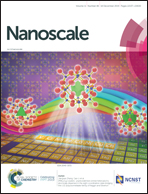Optimal ligand–receptor binding for highly efficient capture of vesicles in nanofluidic transportation†
Abstract
Optimizing ligand–receptor binding is essential for exploiting advanced biomedical applications from targeting drug delivery to biosensing. A key challenge is how optimized ligand–receptor binding can be realized during the transport of ligand-modified soft materials through a nanofluidic channel. Here, by combining computer simulations and theoretical analysis, we report that the ligand–receptor binding and resulting capture probability of ligand-functionalized vesicles nonmonotonically depend on their some intrinsic properties, e.g., chain stiffness and vesicle rigidity, during their transport through a nanochannel with imposed Poiseuille flow. Particularly, we find that the systems with semiflexible ligand and receptor chains possess the optimal ligand–receptor binding and capture probability. An analytical model of the blob theory is developed to capture the simulation results quantitatively, leading to a mechanistic interpretation of the optimal vesicle capture based on the conformational-entropy effect. Examination of the detailed dynamics reveals the active rearrangement of ligand–receptor binding during the transport process. Furthermore, the hairy vesicle with moderate rigidity is found to display an enhanced capture probability superior to that of both its soft and hard counterparts, which is rationalized by the faster and more periodic tumbling motion of the semi-rigid vesicle. Our findings highlight that precise control of the intrinsic properties of ligands and receptors as well as the vesicle rigidity can be a versatile strategy in optimizing the ligand–receptor binding in nanofluidic transportation towards advantageous biomedical applications.

- This article is part of the themed collection: Theoretical Modelling at Nano-bio Interfaces


 Please wait while we load your content...
Please wait while we load your content...